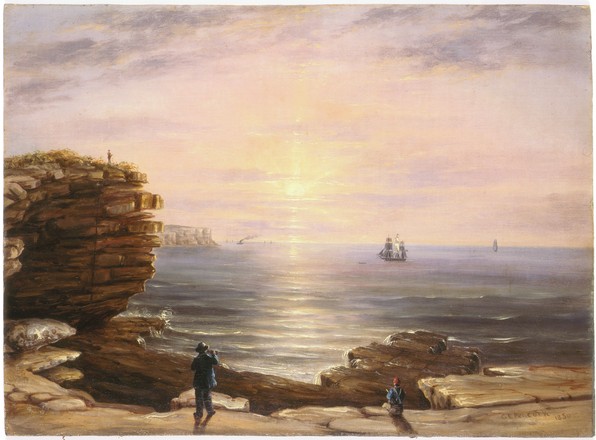Morning at the 'Heads' of Port Jackson, or the Pilot's Look Out
1850
Oil on board
Bequest of Sir William Dixson, 1932
DG 204
With its dramatic rock formations and spectacular views back down the harbour and out to sea, South Head was a popular spot for tourists. It was also used as a lookout post by pilots, whose job was to guide ships safely into the harbour.
By the 1840s, Sydneysiders had embraced the harbour as a place of pleasure, associated with picnics and parties rather than with trade and commerce. Its beauty was proudly celebrated as a counterpoint to the slurs that Europeans liked to throw at the city’s convict origins. Around this time Peacock’s works began appearing on the market, with attractive harbour bays and the exclusive private villas on its foreshores his dominant subject. The number of his works to survive suggest that he was a prolific and therefore a reasonably successful artist.
The gates of Paradise
Colonists took great pride in the beauty of Sydney Harbour, enjoying both its views and the lavish praise it received from visitors to counter the enduring slurs about the city’s convict origins. Edward Lucett, who arrived in Sydney in July 1837, spoke of sailing through the Heads as ‘entering the gates of Paradise’ [1]. Artist George French Angas wrote of the inconceivable beauty of the harbour, whose ‘shores are indented by numerous charming little bays where the transparent blue waters murmur gently upon a smooth beach of sand of the most dazzling whiteness and these are relieved by clusters of deep rich foliage with bold and rocky eminences jutting abruptly out from some miniature promontory’ [2].
Footnotes
1.Edward Lucett, Rovings in the Pacific, from 1837 to 1849, 1851, vol 1, p 41
2. George French Angas, Savage Life and Scenes in Australia and New Zealand, 1847, vol 1, p 42
A meditation on exile?
This painting is perhaps Peacock’s meditation about his exile and distance from ‘home’. Writers of the time often noted that ships entering Sydney Harbour were the colony’s only connection to the rest of the world, and you get a very strong sense of that in this painting. It’s an unusual work in that most of the views from this point face the other way, looking down the Harbour itself towards Sydney. But looking out at a sea enveloped by an almost mystical sunrise – there is a distinct feeling of Peacock’s own sense of dislocation and despondency at his situation.



 Back to list
Back to list